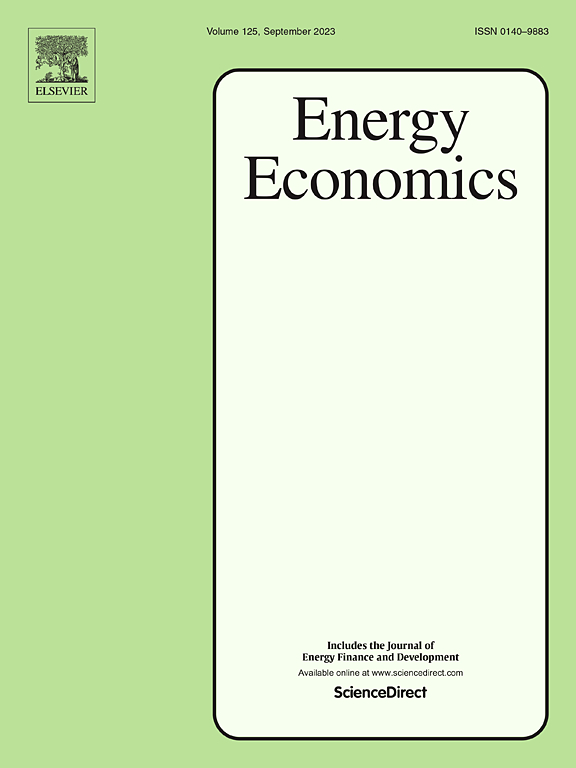机器替代的碳锁定和资源锁定效应:来自54个国家的证据
IF 14.2
2区 经济学
Q1 ECONOMICS
引用次数: 0
摘要
在机器替代劳动力的时代,准确评估这种替代对碳排放和生态系统影响的作用,对于改善有偏见的环境政策至关重要。利用2005 - 2019年54个国家的面板数据,构建了一个四维分析框架,结果表明:(1)机器替代对碳排放和生态足迹的正回归系数表明,从长期和总体上看,机器替代具有碳锁定效应和资源锁定效应。这一结论得到了一系列稳健性和内生性检验的支持。(2)群体回归表明,生态弹性的正相关仅在高收入国家和发达国家显著。在分位数回归中,被解释变量的分位数越大,生态弹性系数越大。这说明机器替代的碳锁定和资源锁定具有聚集效应。(3)消费主义盛行和能源剪刀差是机器替代导致的碳锁定和资源锁定的间接因素,受经济和收入水平的影响。(4)在超过一定阈值时,机器替代的碳锁定和资源锁定呈现非递增的非线性边际效应,表明消费主义盛行和能源剪刀差的负面效应受到其他因素的制约。在实施智能家电和电动汽车补贴等政策时,重要的是要仔细平衡与消费主义相关的经济效益和环境成本本文章由计算机程序翻译,如有差异,请以英文原文为准。
Carbon lock-in and resource lock-in effects of machine substitution: Evidence from 54 countries
In the era of machine substitution for labor, accurately assessing the role of this substitution in carbon emissions and ecosystem impact is crucial for improving biased environmental policies. Drawing on panel data from 54 countries between 2005 and 2019, this study constructs a four-dimensional analytical framework and finds that: (1) the positive regression coefficients of machine substitution with carbon emissions and ecological footprints indicate that, in the long term and overall, machine substitution has carbon lock-in and resource lock-in effects. This conclusion is supported by a series of robustness and endogeneity tests. (2) Group regression reveals that the positive correlation of ecological elasticity is only significant in high-income and developed countries. In quantile regression, the larger the quantile of the explained variable, the greater the ecological elasticity coefficient. This indicates that the carbon lock-in and resource lock-in of machine substitution have an aggregating effect. (3) The prevalence of consumerism and the energy scissors difference are indirect factors for the carbon lock-in and resource lock-in caused by machine substitution, which are influenced by economic and income levels. (4) When exceeding a certain threshold, the carbon lock-in and resource lock-in of machine substitution have a non-linear effect of non-increasing marginality, suggesting that the negative effects of the prevalence of consumerism and the energy scissors difference are constrained by other factors. When implementing policies such as subsidies for smart appliances and electric vehicles, it is important to carefully balance the economic benefits with the environmental costs associated with consumerism
求助全文
通过发布文献求助,成功后即可免费获取论文全文。
去求助
来源期刊

Energy Economics
ECONOMICS-
CiteScore
18.60
自引率
12.50%
发文量
524
期刊介绍:
Energy Economics is a field journal that focuses on energy economics and energy finance. It covers various themes including the exploitation, conversion, and use of energy, markets for energy commodities and derivatives, regulation and taxation, forecasting, environment and climate, international trade, development, and monetary policy. The journal welcomes contributions that utilize diverse methods such as experiments, surveys, econometrics, decomposition, simulation models, equilibrium models, optimization models, and analytical models. It publishes a combination of papers employing different methods to explore a wide range of topics. The journal's replication policy encourages the submission of replication studies, wherein researchers reproduce and extend the key results of original studies while explaining any differences. Energy Economics is indexed and abstracted in several databases including Environmental Abstracts, Fuel and Energy Abstracts, Social Sciences Citation Index, GEOBASE, Social & Behavioral Sciences, Journal of Economic Literature, INSPEC, and more.
 求助内容:
求助内容: 应助结果提醒方式:
应助结果提醒方式:


